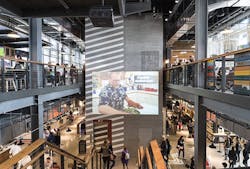Cities and suburbs are constantly changing and 2017 served up more than its share of challenges—some we saw coming (massive retail closures), while others took us by surprise (historic flooding and other natural disasters).
2017 saw the continuation of the evolution of expectations on the part of consumers, developers, office workers, and cities. Those expectations? Urban design and development is no longer “business as usual.” In that spirit, here are six urban design trends to watch in 2018:
Gensler’s concept for the Brooklyn Queens Cross Line Image © Gensler.
1. Experience, Not Just Place
“Place-making,” once the watchword of every urban designer, is no longer enough. Now it is all about experience—how buildings and the spaces between them are treated in relation to human-scale design. Developers are rediscovering the importance of leveraging authenticity and contextualism—“franchise architecture” and cookie-cutter designs are out. Experience has real dollar value—from adjacency to open space to unique developments as destinations. Experience brings customers back again and again—not just for the retail offerings, but also for the sense of belonging and ownership.
2. Retail Reinvention
No doubt 2017 was the year of retail upheaval. Last year, over 6,700 stores closed across the United States (more if you include restaurant closures), and 3,900 more are projected to shutter in 2018. Retail analysts also predict a seismic shift in regional malls, with as many as 25 percent in danger of closure. Amazon and online sales may be convenient scapegoats, but mergers and acquisitions, changing consumer habits, and the oversaturation of retail for the past few decades are also to blame. A day of reckoning was inevitable.
3. Re-Greening
Even with Frederick Law Olmstead’s influential “emerald necklace” park systems and major parks like New York’s Central Park, open space was all too often relegated to "left-over" or secondary space. No more.
4. Re-Urbanizing
Decades of suburban sprawl led to the creation of boring, single-use developments and empty downtowns. In response, many mixed-use projects sought to recreate familiar pre-World War II patterns, but these do not always respond to today’s consumer expectations.
5. Future-Proofing
All developers try to get as much use from a building as possible. But what happens to parking garages if demand decreases? Traffic engineers are projecting that the United States may have already reached “peak parking.” With rising popularity in shared car and on-demand ride services, car use may be leveling out, even before the arrival of self-driving cars.
6. Food Halls
A previous post addressed this rising trend in 2016. And while food halls have been around for centuries, last year saw a rekindling of interest in cities and suburbs. The food hall has become the next “must have.”
What’s Next? In 2018, Autonomous Vehicles will continue to make strides, including at the regulatory and insurance levels. Expect the first practical rollout of driverless shuttle buses to hit our streets, followed by Connected Car technology, with AV’s sometime after that. That’s when things really get interesting.
About the Author
Gensler
A global design firm with more than 5,000 practitioners networked across five continents, Gensler features insights and opinions of architects and designers on how design innovation makes cities more livable, work smarter, and leisure more engaging. Our contributors write about projects of every scale, from refreshing a retailer’s brand to planning a new urban district, all the while explaining how great design can optimize business performance and human potential. For more thought leadership and blog content, visit our Research & Insight page. Follow us on Facebook, LinkedIn, and Twitter.
